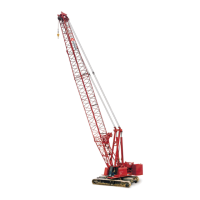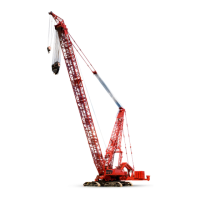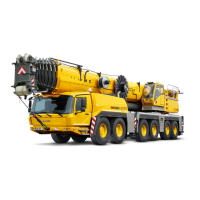Manitowoc Published 10-01-2012, Control # 045-08 1-25
777 SERVICE MANUAL INTRODUCTION
1
equal value; likewise, the two lines entering the
instrumentation amplifier from the bridge are equal in value
causing the output signal from the instrumentation amplifier
to the PC to be approximately 1 volt.
When the pressure sender is exposed to system pressure, a
pressure greater than 0 psi, the strain gages (located on the
flathead sensor) will stretch and increase in resistance. A
milivoltage voltage differential then occurs in the two lines
going to the instrumentation amplifier from the strain gage/
resistor bridge. The differential voltage is amplified causing
the output voltage from the instrumentation amplifier to be
greater than one volt. The output voltage signal to the PC is
proportional to the increase in pressure. At full pressure the
voltage signal is 5 volts. This situation is true of any pressure
transducer used.
Crane Select and Confirm Switch
The operator uses the crane selector mode switch to select
and confirm the crane operation mode at startup. Modes that
can be selected and confirmed are: standard, clamshell,
dragline, and luffing.
Calibrate the hydraulic pressure senders by establishing a 0
reference for pressure before engine startup. This process
will occur when the crane Select/Confirm switch is held in the
confirm position prior to placing the Run/Stop switch into the
run position while continuing to hold the Confirm/Select
switch in the confirm position for 60 seconds. The calibration
of each hydraulic pressure sender will remain in the PC’s
memory until the next calibration. The pressure senders
should be calibrated when the displayed pressure changes
from normal operating range or possibly at six months
maintenance intervals.
Holding the Select/Confirm switch in the Select position
while actuating the Limit Bypass switch at the same time
allows the operator to select the desired display language:
English or applicable foreign language.
Engine and Fluid Monitoring
See Figure 1-16 for following procedures.
The crane has a engine oil pressure switch, engine coolant
temperature switch, hydraulic fluid level switch, and
hydraulic fluid temperature switch. These switches provide a
system fault alert or warning to the operator by displaying the
system fault on scroll display, and actuate an intermittent
blinking red light and beeper when the switch of the affected
system opens or closes and is detected by the PC. All
system fault alerts that may occur while operating the crane
are listed in Table 10-3 of the Digital Display Readings in
Section 10 of this manual. The faults can be accessed by the
operator in the system fault section of the digital. After the
cause for the fault is corrected, the alert turns off.
The PC also makes regulated voltage available to boom and
luffing jib angle indicators. The angle indicators are
inclinometers that provide the PC with a logarithmic voltage,
which is proportional to the position of the boom or jib. The
PC interprets the information and displays it in degrees on
the scroll display.

